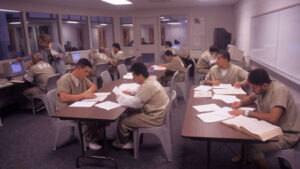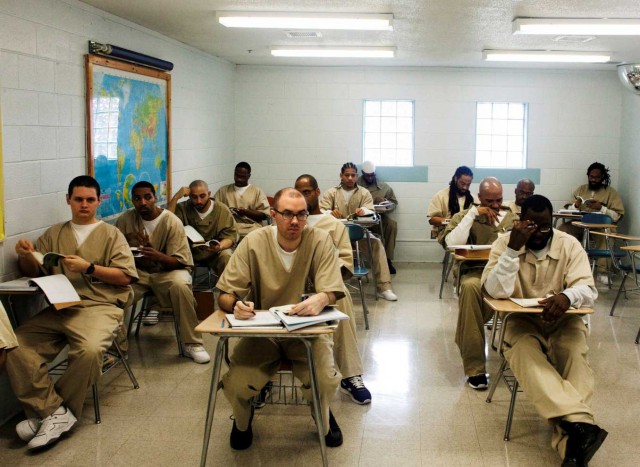The politics of programming in the penitentiary can be complicated because of how the system is set up. There are over two hundred thousand people incarcerated today in the federal prison system. This number encompasses every level of security throughout the bureau of prisons, from the minimally controlled camps to the fortified penitentiaries.
When everyone of these individuals was sentenced by the United States of America they all had one thing in common; the opportunity to choose how they will serve their time. The choice to either make the most of themselves out of a bad situation, or get swallowed up in the belly of the beast.
Most inmates go the “convict” route when they enter their new dwellings. Getting high, gambling, and sitting in front of the TV is how they choose to pass the time. Others workout and play sports to bide their time inside. While the other small minority try to take classes and programs that will give them a fighting chance to stay out of the concrete jungle that confines them. What those in the final assemblage discover is their path through education is the most arduous of them all.
Just to set foot inside a classroom in the BOP takes overcoming multiple obstacles. The first of which is for there to actually be a class to walk into.
In the lower security institutions there is no shortage of vocational training and other programs to help set a foundation towards a successful release from prison. Out of the two hundred thousand inmates, twenty four thousand are housed behind the maximum security electric fences of the penitentiary. Inside these penitentiaries, none of these programs exist. Most people on the outside believe that there is a multitude of college courses and job training that is provided inside these gates. But the only classes available for the population are created and taught by fellow inmates.
Behind these walls, inmates have to abide by two sets of rules. Those levied by the administration and the other, far more critical precepts, enforced by the convicts.
The first set of rules will only get you thrown in segregation, with a loss of privileges. Breaking the latter set of regulations can get you killed. With the administrations bylaws written in black and white, it’s easy to know when you’re breaking the rules. But with the convicts code of ethics, it’s more open to interpretation. That judgment of right or wrong falls squarely on the shoulders of whoever has the most numbers on the yard.
If you’re well liked on the compound, or “good for the economy” then you can do no wrong. The more “homeboys” you have to back you up, the more you can get away with.
Sticking to yourself and doing your own thing is the best way to leave prison without any permanent scars. But the less you interact with the population, the easier it is for you to be “voted off the island”. If you don’t have “good dudes” backing you up, any little thing can get you hit.
Prison basically boils down to a popularity contest. The “cool cons” are the head politicians who interpret policy on their constituency. While their cronies are the ones that implement the brutality of their decrees.
The constant fluxuation of leaders or “shot callers” can easily make what was once legal under a previous regime, a death sentence below a new oligarchy. These prison politics are one of the biggest hindrances there are towards inmates educating themselves for a successful release into society.
In the penitentiary, if you’re going to talk to a staff member, you have to bring another inmate with you. This is to ensure the “community” that you’re not telling on something. It doesn’t matter that there’s countless other ways to “rat”, if you’re going to do so. This precept has been a staple in the convicts code for decades.
 With this statute firmly enforced, it makes any type of one on one learning, with anyone other then an inmate, almost non-existent. The only way for someone to get the extra help they require, is through an inmate tutor or facilitator. This in return creates a catch-22 for those that are willing to help.
With this statute firmly enforced, it makes any type of one on one learning, with anyone other then an inmate, almost non-existent. The only way for someone to get the extra help they require, is through an inmate tutor or facilitator. This in return creates a catch-22 for those that are willing to help.
The inmate instructors, at some point will be alone around the staff members over-seeing the program. Whether it’s turning in tests, requesting copies of materials, or simply asking for pencils, the inmate’s going to “slip” and do it unaccompanied.
At that point it’s all up to the inmates popularity on the yard, and how the shot caller is feeling that day whether or not that little slip just got them jumped from behind by two convicts on their way to chow. Another stigma an inmate educator faces is the view that they are “being the police”. This belief materializes out of their position of authority.
Most inmate facilitators are held responsible for the classrooms they teach in. This includes taking attendance and making sure nothing inside of the rooms is destroyed. This can lead to major problems. Marking a person down as being absent is the same thing in some cons eyes as getting up on the stand, pointing your finger directly at someone, and shouting “He did it!”
Also, in a world where everything is a potential weapon, convicts are always on the hunt for a new trinket they can file down into a point. When an inmate instructor has to stop them from dismantling a typewriter, TV, or desk, some serious retaliation can be expected.
The teacher also has to interact with convicts that want credit for a class and never showing up. When they’re denied the accreditation, a verbal confrontation is the best case scenario that is sure to follow.
From the students perspective, they have to deal with other convicts taunting them for going to class. The same way it was in elementary school when there was always that one kid that had to say something demeaning, prison holds the same cards. Which of course, leads to the minions throwing in their two cents worth.
The student can also get into a situation with the shot callers if something is transpiring on the yard and they’re not there to crash out with everyone else. Trying to get educated is no excuse to a politico when they want you to fall on a knife for them. Misery loves company, and prison is the number one exporter in the business.
There are two thousand inmates leaving the federal penitentiaries every year. The recidivism rate for those individuals is at a staggering high. With one out of every two getting arrested within the first year of their release, and two thirds reentering the system within five years, it’s easy to recognize that changes must come from both sides. Until that happens, those seeking to better themselves inside these walls, will find their path to freedom as the most formidable one.



